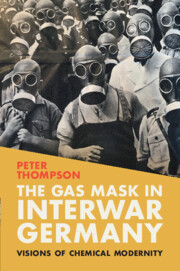Book contents
- The Gas Mask in Interwar Germany
- Science in History
- The Gas Mask in Interwar Germany
- Copyright page
- Dedication
- Contents
- Figures
- Tables
- Acknowledgments
- Abbreviations
- Introduction
- 1 The Structures of Violence: Fritz Haber and the Institutionalization of Gas Warfare
- 2 The Man in the Rubber Mask: World War I and the Development of the Modern Gas Mask
- 3 The First “Chemical Subjects”: Soldier Encounters with the Gas Mask in World War I
- 4 The Limits of Sympathy: The Medical Treatment of Poison Gas during and after World War I
- 5 Atmos(fears): The Poison Gas Debates in the Weimar Republic
- 6 Technologies of Fate: Cultural and Intellectual Prophesies of the Future Gas War
- 7 Synthesizing the “Nazi Chemical Subject”: Gas Masks, Personal Armoring, and Vestiary Discipline in the Third Reich
- 8 Prophets of Poison: Industrialized Murder in the Gas Chambers of the Holocaust
- Conclusion
- Bibliography
- Index
5 - Atmos(fears): The Poison Gas Debates in the Weimar Republic
Published online by Cambridge University Press: 11 May 2023
- The Gas Mask in Interwar Germany
- Science in History
- The Gas Mask in Interwar Germany
- Copyright page
- Dedication
- Contents
- Figures
- Tables
- Acknowledgments
- Abbreviations
- Introduction
- 1 The Structures of Violence: Fritz Haber and the Institutionalization of Gas Warfare
- 2 The Man in the Rubber Mask: World War I and the Development of the Modern Gas Mask
- 3 The First “Chemical Subjects”: Soldier Encounters with the Gas Mask in World War I
- 4 The Limits of Sympathy: The Medical Treatment of Poison Gas during and after World War I
- 5 Atmos(fears): The Poison Gas Debates in the Weimar Republic
- 6 Technologies of Fate: Cultural and Intellectual Prophesies of the Future Gas War
- 7 Synthesizing the “Nazi Chemical Subject”: Gas Masks, Personal Armoring, and Vestiary Discipline in the Third Reich
- 8 Prophets of Poison: Industrialized Murder in the Gas Chambers of the Holocaust
- Conclusion
- Bibliography
- Index
Summary
The fifth chapter continues the narrative of German poison gas production into the 1920s. Still tied to Fritz Haber and his protégés, most of this work was either hidden under the guise of pesticide research or conducted in the Soviet Union through clandestine armament deals. Both this illegal poison gas production and national debates surrounding rearmament inspired a significant interwar pacifist response. Focusing on the antigas activism of the chemist Gertrud Woker, this chapter further evaluates the rhetorical methods with which pacifists critiqued poison gas research and production. The antigas movement inspired several international disarmament and peace treaties throughout the 1920s. However, the enforcement and popularization of these treaties proved difficult as both fears over national security and visions of future aero-chemical war proliferated. A 1928 gas leak at a Hamburg chemical plant stoked these fears into a distinct call for greater national security, thus encouraging the swift political rise of the so-called gas specialists. Through their gas protection journals and their public demonstrations, this loosely affiliated group of scientists and engineers succeeded in putting pressure on the Weimar government to increase its focus on civilian air and gas protection at the expense of international disarmament agreements.
- Type
- Chapter
- Information
- The Gas Mask in Interwar GermanyVisions of Chemical Modernity, pp. 132 - 178Publisher: Cambridge University PressPrint publication year: 2023

